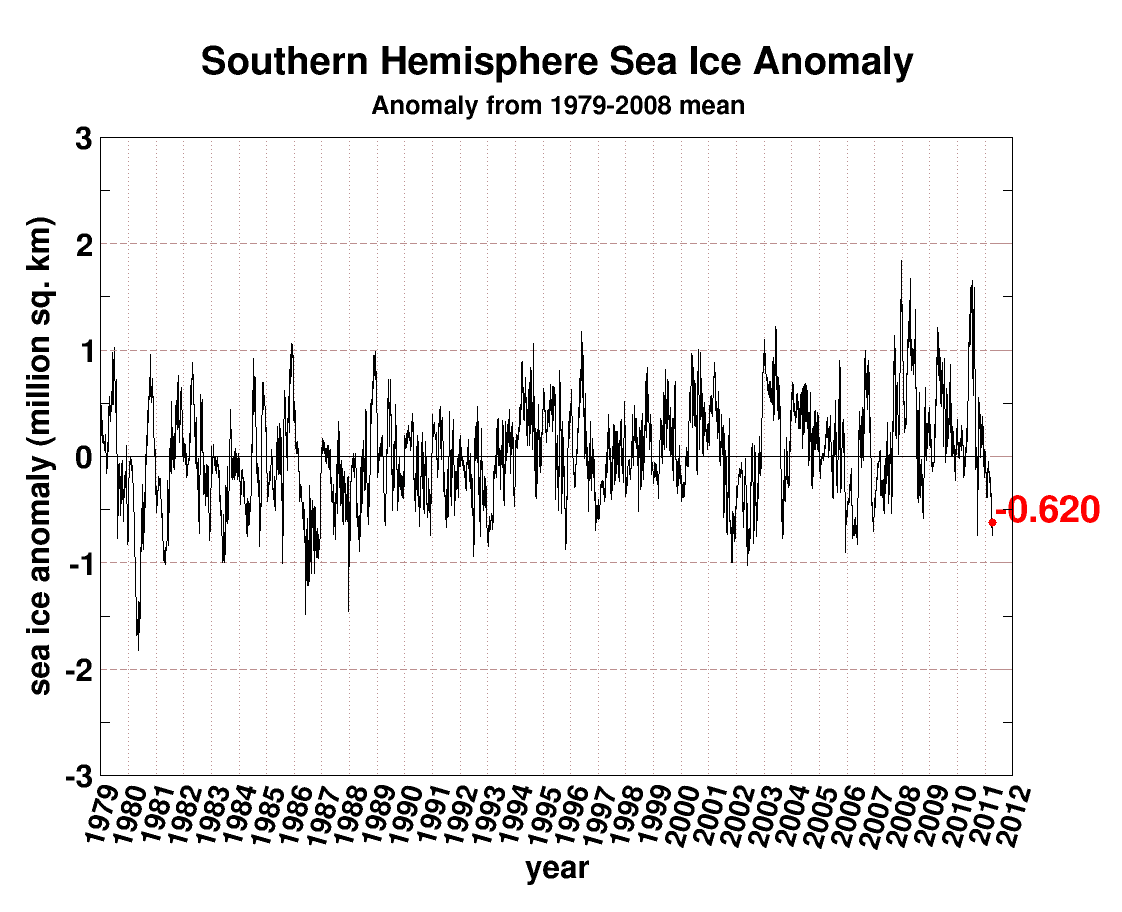Antarctic ice, which has hit record highs in recent years, is decreasing and increasing simultaneously.
http://arctic.atmos.uiuc.edu/cryosphere/IMAGES/seaice.anomaly.antarctic.png
Climate change has hit species of Antarctic penguins by causing a staggering decline in their prey: krill. A new study in the Proceedings of the National Academy of Sciences (PNAS) has found that both chinstrap penguins (Pygoscelis antarcticus) and Adélie penguins (Pygoscelis adeliae) have seen their populations decline likely do to less krill, instead of habitat changes. Since 1970 krill populations have fallen by 80% in the Southern Ocean surrounding Antarctica. Because krill require sea ice to reproduce, shrinking sea ice from climate change has made it more difficult for them to breed.



This canard again? Wasn’t it determined that disease spread by researchers and banding by the researchers caused the decline in population?
http://www.nature.com/nature/journal/v469/n7329/full/nature09630.html
I love when I can answer my own questions!
Well, yes, James you are correct! Turns out, the pinheaded researchers, who love to blame mankind for the demise of all sorts of critters, are to blame and responsible for population decrease in the animals they use to bludgeon people with.
Another story worth reading….. http://www.wormsandgermsblog.com/uploads/file/847.pdf
You are right. We should make banding of any species a crime against nature. These are pretty sick people that do this. But I guess the alternative is to get a real job instead of expecting to get paid for a permanent holiday.
It’s not just flipper banding that’s hindering the penguins ability to feed but also disease.
http://www.antarctica.gov.au/about-antarctica/australian-antarctic-magazine/issue-15-2008/a-virus-amongst-the-penguins
More human disease introduced to penguins.
Q. What is always increasing and decreasing at the same time?
A. It’s called a Monotonic function.
When mathematicians talk about increasing and decreasing, they distinguish between strictly increasing and monotone increasing, a constant function is neither strictly increasing nor strictly decreasing.
The best way I can explain this is, If you have an Ice cap which decreases in mass and never increases this is called “strictly decreasing” (which is a constant function) but if you have an ice cap that both decreases and increases this is called a “Monotonic Function”.
If the process of Antarctica is a “Monotonic function” (which it is) where it both decreases and increases in mass, it is therefore Not strictly decreasing as a constant function.
I hope I explained this right!! It’s a little bit complex.
laugh out Loud, Fall On Floor, Bla Bla Bla…
A sparkling explanation. I enjoyed it’s exquisite contortions.
Intended!! not many people can spot an extremely complex over the top form of humor!!
Sorry, but you haven’t got it right at all. “Monotonic” means “one direction”. A monotonically increasing function is one that never decreases. In some contexts, you can say that a “strictly monotonic” function has no areas of zero change or decrease.
Curt,
that’s not what I was trying to explain.
I was inferring the term to the meaning of maintaining order or the sense of no change through change.
Curt says:
“A monotonically increasing function is one that never decreases”
Your not completely wrong in a way, you have misunderstood my context. A monotonically strictly increasing function is one that never decreases, I was not describing a monotonically strictly increasing function as a process.
“Monotone” If a function is strictly increasing, it increases steadily, without staying constant. A monotone increasing function, is increasing, but is allowed intervals where it stays constant. Decreasing is the same, only in the opposite direction.
The constant function that I’m trying to describe above is both monotone increasing and monotone decreasing. as in a “constant function” where it is neither strictly increasing nor strictly decreasing. (Ice caps increase & decrease they do not strictly decrease or increase)
“The term “monotonic” conveys the meaning of maintaining order or the sense of “no change”. In the context of function, we think a monotonic function as the one whose successive values are increasing, decreasing or constant. There is a sense of maintaining order of function values as independent variable changes. These aspects are pictorially evident on the graph of a function. In a general case, a function may or may not maintain its order of change in its domain i.e. in the overall context. However, we can always identify monotonic behavior in an appropriately chosen subset of domain – unless it is a point function or a singleton.”
SOURCE: http://cnx.org/content/m15463/latest/
Bollocks!
Stop tagging penguins and reducing their hunting abilities.
Guess what else correlates with “global” warming — Antarctic krill fishery catch.
See: http://www.appinsys.com/GlobalWarming/RS_Antarctica.htm – near the end of the page for krill fishery graph.
Just like is the Arctic and the seals, the krill need the ice as a protected location where they can give live birth to their off spring and raise their young until the infants can get strong enough to survive in the water! 😉
Shrinking sea ice makes it more difficult for penguins to breed, eh… or maybe its because its so cold that the boy-pengiuns are shrinking! Wink-wink!